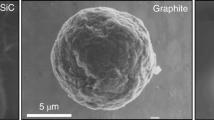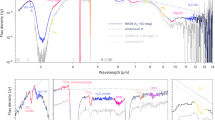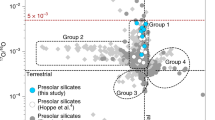Abstract
Whether ice in cold cosmic environments is physically separated from the silicate dust or mixed with individual silicate moieties is not known. However, different grain models give very different compositions and temperatures of grains. The aim of the present study is to compare the mid-infrared spectra of laboratory silicate grain/water ice mixtures with astronomical observations to evaluate the presence of dust/ice mixtures in interstellar and circumstellar environments. The laboratory data can explain the observations, assuming reasonable mass-averaged temperatures for the protostellar envelopes and protoplanetary disks, demonstrating that a substantial fraction of water ice may be mixed with silicate grains. On the basis of the combination of laboratory data and infrared observations, we provide evidence of the presence of solid-state water in the diffuse interstellar medium. Our results have implications for future laboratory studies investigating cosmic dust grain analogues and for future observations trying to identify the structure, composition and temperature of grains in different astrophysical environments.
This is a preview of subscription content, access via your institution
Access options
Access Nature and 54 other Nature Portfolio journals
Get Nature+, our best-value online-access subscription
$29.99 / 30 days
cancel any time
Subscribe to this journal
Receive 12 digital issues and online access to articles
$119.00 per year
only $9.92 per issue
Buy this article
- Purchase on Springer Link
- Instant access to full article PDF
Prices may be subject to local taxes which are calculated during checkout




Similar content being viewed by others
Data availability
The data that support the plots within this paper and other findings of this study are available from the corresponding author upon reasonable request.
References
Dorschner, J. & Henning, T. Dust metamorphosis in the Galaxy. Astron. Astrophys. Rev. 6, 271–333 (1995).
Draine, B. T. Interstellar dust grains. Annu. Rev. Astron. Astrophys. 41, 241–289 (2003).
Whittet, D. C. B. Dust in the Galactic Environment (IOP Publishing, 2003).
Ciaravella, A. et al. Chemical evolution of interstellar methanol ice analogs upon ultraviolet irradiation: the role of the substrate. Astrophys. J. 858, 35 (2018).
Potapov, A., Jäger, C., Henning, T., Jonusas, M. & Krim, L. The formation of formaldehyde on interstellar carbonaceous grain analogs by O/H atom addition. Astrophys. J. 846, 131 (2017).
Potapov, A., Jäger, C. & Henning, T. Photodesorption of water ice from dust grains and thermal desorption of cometary ices studied by the INSIDE experiment. Astrophys. J. 880, 12 (2019).
Potapov, A., Theule, P., Jäger, C. & Henning, T. Evidence of surface catalytic effect on cosmic dust grain analogues: the ammonia and carbon dioxide surface reaction. Astrophys. J. Lett. 878, L20 (2019).
Suhasaria, T., Thrower, J. D. & Zacharias, H. Thermal desorption of astrophysically relevant molecules from forsterite(010). Mon. Not. R. Astron. Soc. 472, 389–399 (2017).
Rosu-Finsen, A. & McCoustra, M. R. S. Impact of oxygen chemistry on model interstellar grain surfaces. Phys. Chem. Chem. Phys. 20, 5368–5376 (2018).
Potapov, A., Jäger, C. & Henning, T. Temperature programmed desorption of water ice from the surface of amorphous carbon and silicate grains as related to planet-forming disks. Astrophys. J. 865, 58 (2018).
Potapov, A., Mutschke, H., Seeber, P., Henning, T. & Jäger, C. Low-temperature optical properties of interstellar and circumstellar icy silicate grain analogs in the mid-infrared spectral region. Astrophys. J. 861, 84 (2018).
Potapov, A., Jäger, C. & Henning, T. Ice coverage of dust grains in cold astrophysical environments. Phys. Rev. Lett. 124, 221103 (2020).
Brownlee, D. et al. Comet 81P/Wild 2 under a microscope. Science 314, 1711–1716 (2006).
Fulle, M. et al. The dust-to-ices ratio in comets and Kuiper belt objects. Mon. Not. R. Astron. Soc. 469, S45–S49 (2017).
A’Hearn, M. F. Comets as building blocks. Annu. Rev. Astron. Astrophys. 49, 281–299 (2011).
van Dishoeck, E. F. Astrochemistry of dust, ice and gas: introduction and overview. Faraday Discuss. 168, 9–47 (2014).
Harmon, J. K. et al. Radar detection of the nucleus and coma of comet Hyakutake (C/1996 B2). Science 278, 1921–1924 (1997).
Hörz, F. et al. Impact features on Stardust: implications for comet 81P/Wild 2 dust. Science 314, 1716–1719 (2006).
Fulle, M., Levasseur-Regourd, A. C., McBride, N. & Hadamcik, E. In situ dust measurements from within the coma of 1P/Halley: first-order approximation with a dust dynamical model. Astron. J. 119, 1968–1977 (2000).
Fulle, M. & Blum, J. Fractal dust constrains the collisional history of comets. Mon. Not. R. Astron. Soc. 469, S39–S44 (2017).
Kataoka, A., Tanaka, H., Okuzumi, S. & Wada, K. Fluffy dust forms icy planetesimals by static compression. Astron. Astrophys. 557, L4 (2013).
Ossenkopf, V. Dust coagulation in dense molecular clouds—the formation of fluffy aggregates. Astron. Astrophys. 280, 617–646 (1993).
Tazaki, R., Tanaka, H., Okuzumi, S., Kataoka, A. & Nomura, H. Light scattering by fractal dust aggregates. I. Angular dependence of scattering. Astrophys. J. 823, 70 (2016).
Wurm, G. & Blum, J. Experiments on preplanetary dust aggregation. Icarus 132, 125–136 (1998).
Krause, M. & Blum, J. Growth and form of planetary seedlings: results from a sounding rocket microgravity aggregation experiment. Phys. Rev. Lett. 93, 021103 (2004).
Jäger, C., Mutschke, H., Henning, T. & Huisken, F. Spectral properties of gas-phase condensed fullerene-like carbon nanoparticles from far-ultraviolet to infrared wavelengths. Astrophys. J. 689, 249–259 (2008).
Sabri, T. et al. Interstellar silicate analogs for grain-surface reaction experiments: gas-phase condensation and characterization of the silicate dust grains. Astrophys. J. 780, 180 (2014).
Knacke, R. F. & Krätschmer, W. Infrared spectra of hydrated silicates, carbonaceous chondrites, and amorphous carbonates compared with interstellar dust absorptions. Astron. Astrophys. 92, 281–288 (1980).
Che, C. C., Glotch, T. D., Bish, D. L., Michalski, J. R. & Xu, W. Q. Spectroscopic study of the dehydration and/or dehydroxylation of phyllosilicate and zeolite minerals. J. Geophys. Res. Planets 116, E05007 (2011).
Stimpfl, M., Walker, A. M., Drake, M. J., de Leeuw, N. H. & Deymier, P. An ångström-sized window on the origin of water in the inner Solar System: atomistic simulation of adsorption of water on olivine. J. Cryst. Growth 294, 83–95 (2006).
Muralidharan, K., Deymier, P., Stimpfl, M., de Leeuw, N. H. & Drake, M. J. Origin of water in the inner Solar System: a kinetic Monte Carlo study of water adsorption on forsterite. Icarus 198, 400–407 (2008).
Gibb, E. L., Whittet, D. C. B., Boogert, A. C. A. & Tielens, A. G. G. M. Interstellar ice: the Infrared Space Observatory legacy. Astrophys. J. Suppl. Ser. 151, 35–73 (2004).
Terada, H. & Tokunaga, A. T. Discovery of crystallized water ice in a silhouette disk in the M43 region. Astrophys. J. 753, 19 (2012).
Boogert, A. C. A., Gerakines, P. A. & Whittet, D. C. B. Observations of the icy universe. Annu. Rev. Astron. Astrophys. 53, 541–581 (2015).
Oba, Y. et al. Formation of compact amorphous H2O ice by codeposition of hydrogen atoms with oxygen molecules on grain surfaces. Astrophys. J. 701, 464–470 (2009).
Fogerty, S., Forrest, W., Watson, D. M., Sargent, B. A. & Koch, I. Silicate composition of the interstellar medium. Astrophys. J. 830, 71 (2016).
Cazaux, S., Cobut, V., Marseille, M., Spaans, M. & Caselli, P. Water formation on bare grains: when the chemistry on dust impacts interstellar gas. Astron. Astrophys. 522, A74 (2010).
Cuppen, H. M. & Herbst, E. Simulation of the formation and morphology of ice mantles on interstellar grains. Astrophys. J. 668, 294–309 (2007).
Jones, A. P. Variations on a theme—the evolution of hydrocarbon solids. I. Compositional and spectral modelling—the eRCN and DG models. Astron. Astrophys. 540, A1 (2012).
Whittet, D. C. B. et al. Infrared spectroscopy of dust in the diffuse interstellar medium toward Cygnus OB2 no. 12. Astrophys. J. 490, 729–734 (1997).
Casu, S., Scappini, F., Cecchi-Pestellini, C. & Olberg, M. The diffuse clouds towards Cyg OB2 no. 5 and no. 12. Mon. Not. R. Astron. Soc. 359, 73–78 (2005).
Whittet, D. C. B. et al. The abundance of carbon dioxide ice in the quiescent intracloud medium. Astrophys. J. 655, 332–341 (2007).
Munoz Caro, G. M. & Schutte, W. A. UV-photoprocessing of interstellar ice analogs: new infrared spectroscopic results. Astron. Astrophys. 412, 121–132 (2003).
Hensley, B. S. & Draine, B. T. Detection of PAH absorption and determination of the mid-infrared diffuse interstellar extinction curve from the sightline toward Cyg OB2-12. Astrophys. J. 895, 38 (2020).
Ardila, D. R. et al. The Spitzer Atlas of Stellar Spectra (SASS). Astrophys. J. Suppl. Ser. 191, 301–339 (2010).
Sloan, G. C., Kraemer, K. E., Price, S. D. & Shipman, R. F. A uniform database of 2.4–45.4 micron spectra from the Infrared Space Observatory Short Wavelength Spectrometer. Astrophys. J. Suppl. Ser. 147, 379–401 (2003).
van Dishoeck, E. F., Bergin, E. A., Lis, D. C. & Lunine, J. I. Water: from clouds to planets. Preprint at https://arxiv.org/abs/1401.8103 (2014).
Jenkins, E. B. A unified representation of gas-phase element depletions in the interstellar medium. Astrophys. J. 700, 1299–1348 (2009).
Poteet, C. A., Whittet, D. C. B. & Draine, B. T. The composition of interstellar grains toward ζ Ophiuchi: constraining the elemental budget near the diffuse-dense cloud transition. Astrophys. J. 801, 110 (2015).
Draine, B. T. Perspectives on interstellar dust inside and outside of the heliosphere. Space Sci. Rev. 143, 333–345 (2009).
Wada, K., Tanaka, H., Suyama, T., Kimura, H. & Yamamoto, T. Collisional growth conditions for dust aggregates. Astrophys. J. 702, 1490–1501 (2009).
Wettlaufer, J. S. Accretion in protoplanetary disks by collisional fusion. Astrophys. J. 719, 540–549 (2010).
Gundlach, B. & Blum, J. The stickiness of micrometer-sized water-ice particles. Astrophys. J. 798, 34 (2015).
Thiel, V., Belloche, A., Menten, K. M., Garrod, T. & Muller, H. S. P. Complex organic molecules in diffuse clouds along the line of sight to Sagittarius B2. Astron. Astrophys. 605, L6 (2017).
Liszt, H., Gerin, M., Beasley, A. & Pety, J. Chemical complexity in local diffuse and translucent clouds: ubiquitous linear C3H and CH3CN, a detection of HC3N and an upper limit on the abundance of CH2CN. Astrophys. J. 856, 151 (2018).
Hudgins, D. M., Sandford, S. A., Allamandola, L. J. & Tielens, A. G. G. M. Mid- and far-infrared spectroscopy of ices—optical constants and integrated absorbances. Astrophys. J. Suppl. Ser. 86, 713–870 (1993).
Narten, A. H., Venkatesht, C. G. & Rice, S. A. Diffraction pattern and structure of amorphous solid water at 10 and 77 °K. J. Chem. Phys. 64, 1106–1121 (1976).
Houck, J. R. et al. The Infrared Spectrograph (IRS) on the Spitzer Space Telescope. Astrophys. J. Suppl. Ser. 154, 18–24 (2004).
Lahuis, F. et al. c2d Spitzer IRS spectra of disks around T Tauri stars. III. [Ne ii], [Fe i], and H2 gas-phase lines. Astrophys. J. 665, 492–511 (2007).
Bouwman, J. et al. The Formation and Evolution of Planetary Systems: grain growth and chemical processing of dust in T Tauri systems. Astrophys. J. 683, 479–498 (2008).
Acknowledgements
We thank E. Gibb and H. Terada for providing the observational data. This work was supported by the Research Unit FOR 2285 ‘Debris Disks in Planetary Systems’ of the Deutsche Forschungsgemeinschaft (grant JA 2107/3–2). T.H. acknowledges support from the European Research Council under the Horizon 2020 Framework Programme via the ERC Advanced Grant Origins 83 24 28.
Author information
Authors and Affiliations
Contributions
A.P. led the project. A.P. and J.B. designed the research and wrote the paper. A.P. performed the laboratory experiments. J.B. performed the analysis of the observational data. C.J. and T.H. participated in data interpretation and discussion.
Corresponding author
Ethics declarations
Competing interests
The authors declare no competing interests.
Additional information
Peer review information Nature Astronomy thanks Herma Cuppen, Erika Gibb and the other, anonymous, reviewer(s) for their contribution to the peer review of this work.
Publisher’s note Springer Nature remains neutral with regard to jurisdictional claims in published maps and institutional affiliations.
Extended data
Extended Data Fig. 1 The normalized 150 K spectra of the silicate/ice mixtures.
MgSiO3/H2O 7.5, Mg2SiO4/H2O 10.5, and MgFeSiO4/H2O 9.0 samples (left) and the MgSiO3/H2O samples with the mass ratios of 2.7 and 7.5 (right).
Extended Data Fig. 2 Amount of trapped water.
Dependence of the volume percentage of remaining water in the silicate/H2O samples at 200 K on the silicate/H2O mass ratio.
Extended Data Fig. 3 ISO-SWS observations of Cyg OB2 12.
The top panel shows the three ISO observations of Cyg OB 2 12 (TDT 33504130, 03602226, and 13901048). The two lower spectra are offset by 5, respectively 10 Jy for clarity. Also, show in this panel are the fitted polynomial continua for the three observations. The lower panel shows the derived optical depth for the three observations (gray curves) and the re-binned average (black curve).
Extended Data Fig. 4 Spitzer IRS observations of Cyg OB2 12.
The top panel shows the data taken in the 3 spectral orders of the short-wavelength module of the low-resolution spectrograph (green, red and blue data points) the short-wavelength module of the high-resolution spectrograph (magenta data points) and the second order of the long-wavelength module of the low-resolution spectrograph (brown data points). Also plotted in his panel is the fitted power-law continuum (black dashed line). The inset figure shows a zoom of the spectral region between 7 and 8 microns. The grey shaded area indicates the position of a blend of HI emission lines. The lower panel shows the derived apparent optical depth profile. The inset panel shows a zoom of the 5.5 to 8 microns spectral region. All plotted error bars represent a 1-sigma uncertainty limit.
Rights and permissions
About this article
Cite this article
Potapov, A., Bouwman, J., Jäger, C. et al. Dust/ice mixing in cold regions and solid-state water in the diffuse interstellar medium. Nat Astron 5, 78–85 (2021). https://doi.org/10.1038/s41550-020-01214-x
Received:
Accepted:
Published:
Issue Date:
DOI: https://doi.org/10.1038/s41550-020-01214-x



